Offensively, they are so excellent that they are the top scorers with 56 goals, while the second top scorers, Feyenoord, have scored only 35 goals.
One of their strengths is set pieces, especially corners.
They are the top scorers from corners in Eredivisie, scoring seven goals so far, while also the top in the UEFA Champions League, scoring two goals (with many others)
In this tactical analysis, we will demonstrate the tactics Peter Bosz‘s side uses in attacking corners, showing how they can even be better and how opponents can face them.
Targeting Luuk de Jong On The Near Post
In this case, we will start demonstrating their usual way of targeting the indicated area by out-swinging cross, targeting Luuk de Jong.
In the photo below, Ajax defend with four zonal defenders (green), a short-option defender (out of the shot), a rebound defender standing on the edge of the box (pink) and four man markers.
PSV’s general structure consists of six players inside the box, a short-option player, and two players on the edge of the box for the rebound.
The two unmarked attackers (against hybrid defending systems) always stand near the zonal line to perform an important part of the plan, so they go to prevent the first two zone defenders from going to the targeted area.
The first one fakes a decoy run to drag the first zonal defender while the second player blocks the second zonal defender.
The remaining four attackers are runners starting from the edge of the box to make the space between the markers and the zonal line bigger, which makes it easy to reach the targeted area.
The second reason is that it gives Luuk de Jong a chance to run enough, earning momentum before jumping, to achieve a dynamic mismatch over the third zonal defender, who jumps from a steady state.
It is worth noting that this far and left position makes it hard for this zonal defender to keep tracking the ball and this pack of runners coming from his blind side at the same time.
The most important trick is that Luuk de Jong runs around his teammate to take him as a score, which means that this teammate blocks Luuk de Jong’s marker when he tries to follow him.
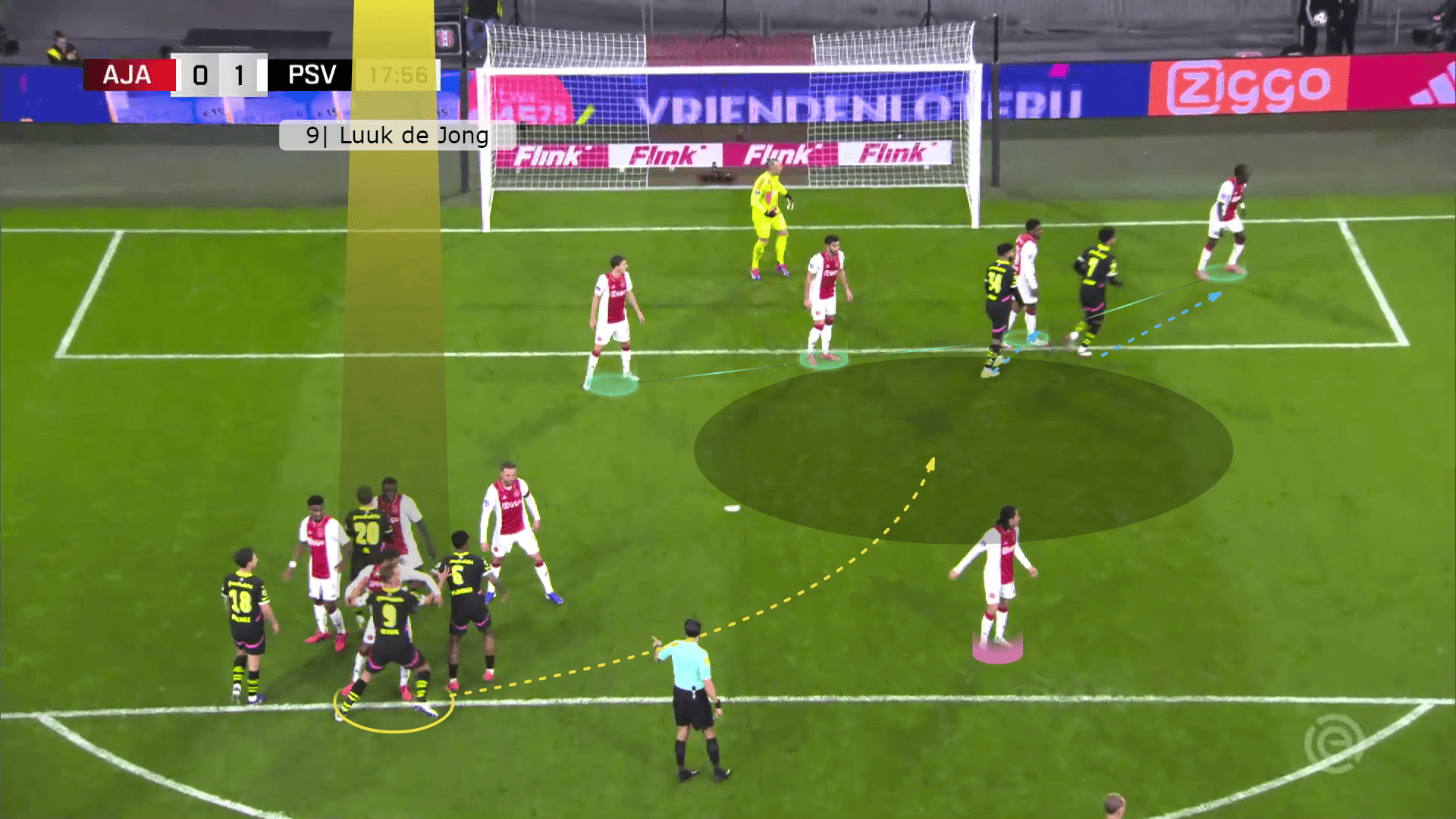
The photo below makes the screen clear, noting that Luuk de Jong comes from the third zonal defender’s blind side while having a dynamic mismatch over him.
The two blue players perform their roles while the remaining two players of the pack (pink) start to go to the far post to frame the goal to be ready in case Luuk de Jong can’t shoot it directly; the goalkeeper saves the ball or any other probability.
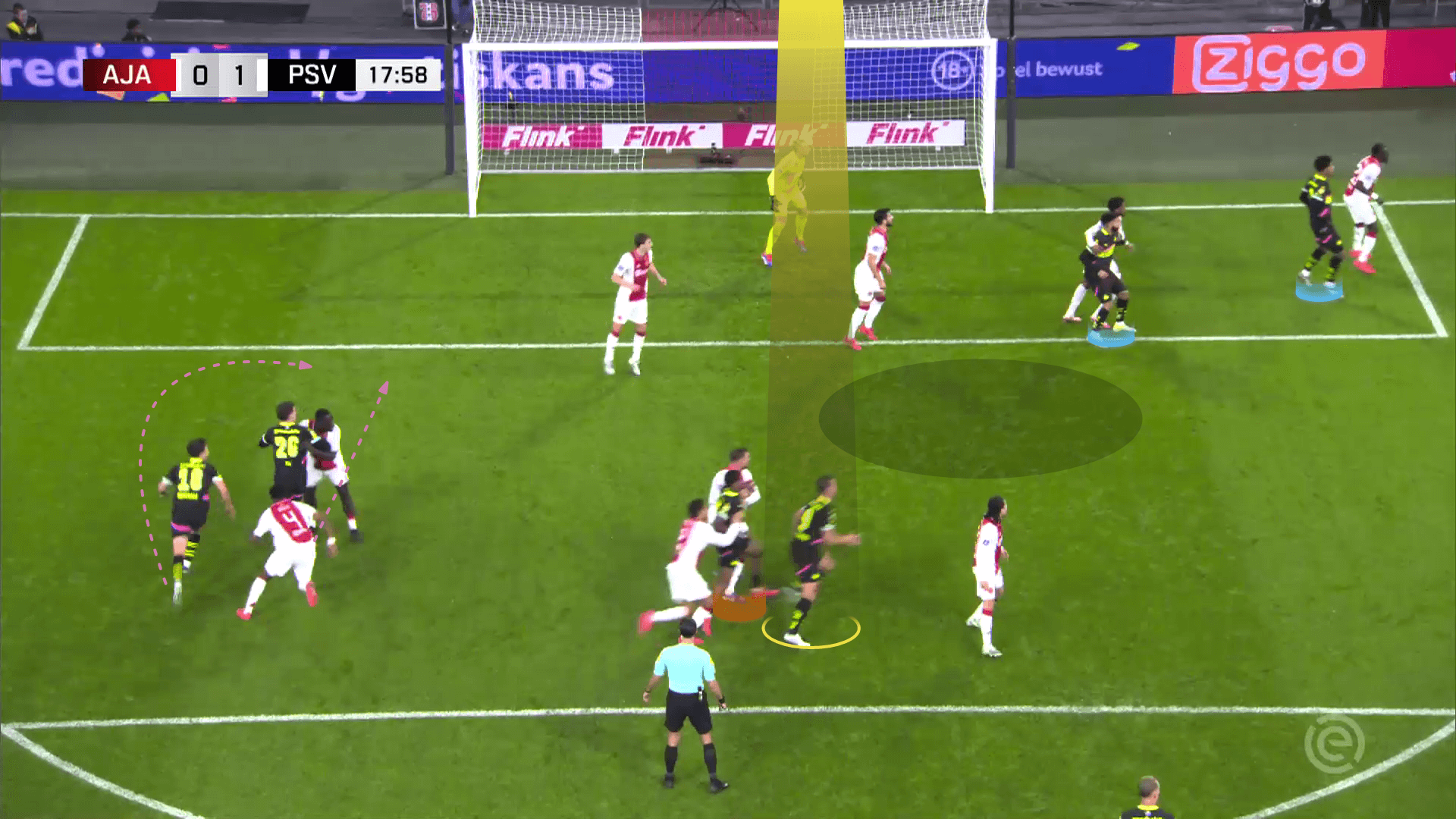
The plan works, and the result is a goal, as shown below.
However, it’s also better to block the third zonal defender instead of one of the two far-post attackers or the decoy run in front of the first zonal defender who is a bit far from the cross trajectory.
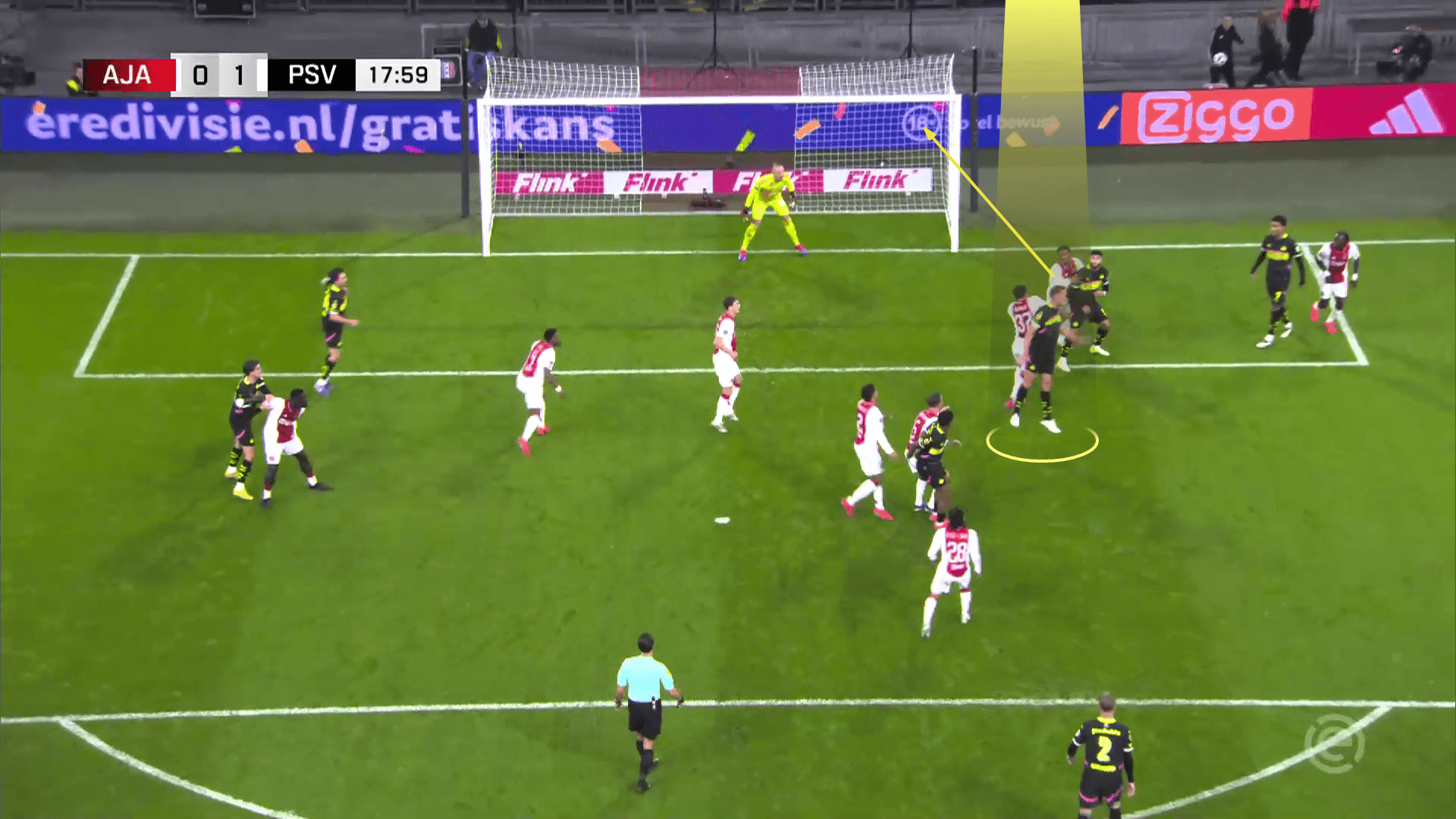
In the case below, they implement a similar idea with a slight variation: they ask Luuk de Jong (green) to perform the screen for his yellow teammate while the two players in the six-yard box (orange) play similar roles.
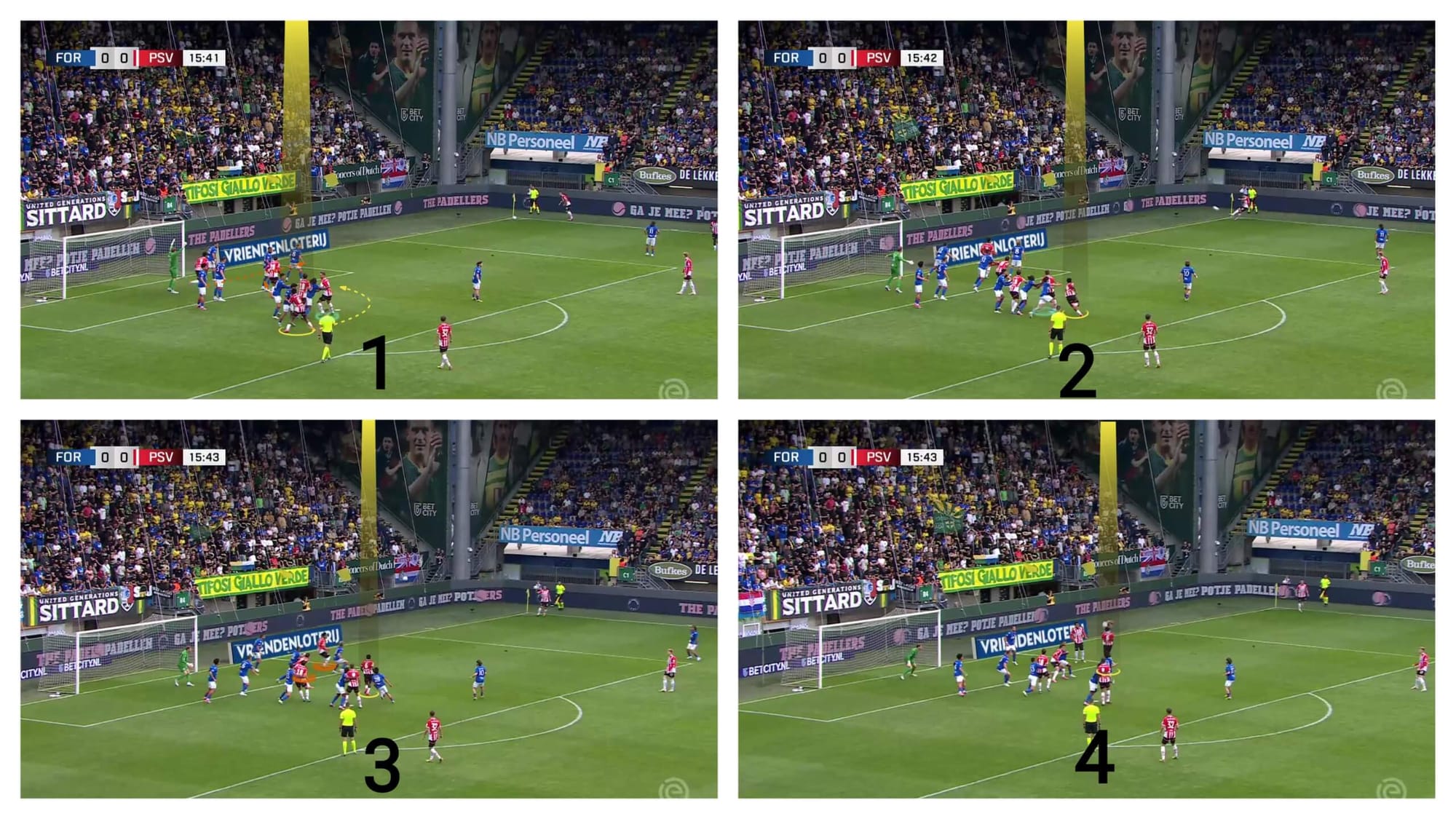
They implement a simple idea against the man-marking defending system, but no players are free while blocking, which demands more perfection in doing the block, so they may neglect blocks or use just one.
In the case below, the opponent defends with a man-marking defending system with only two zonal defenders, a short-option defender and a rebound defender.
Luuk de Jong’s marker tries to wait until he moves to avoid the screen, but this helps him to run free without annoyance in the beginning, which is called a separation.
The standing player in the six-yard box goes to block the second zonal defender in a strange action because the danger comes more from the first one.
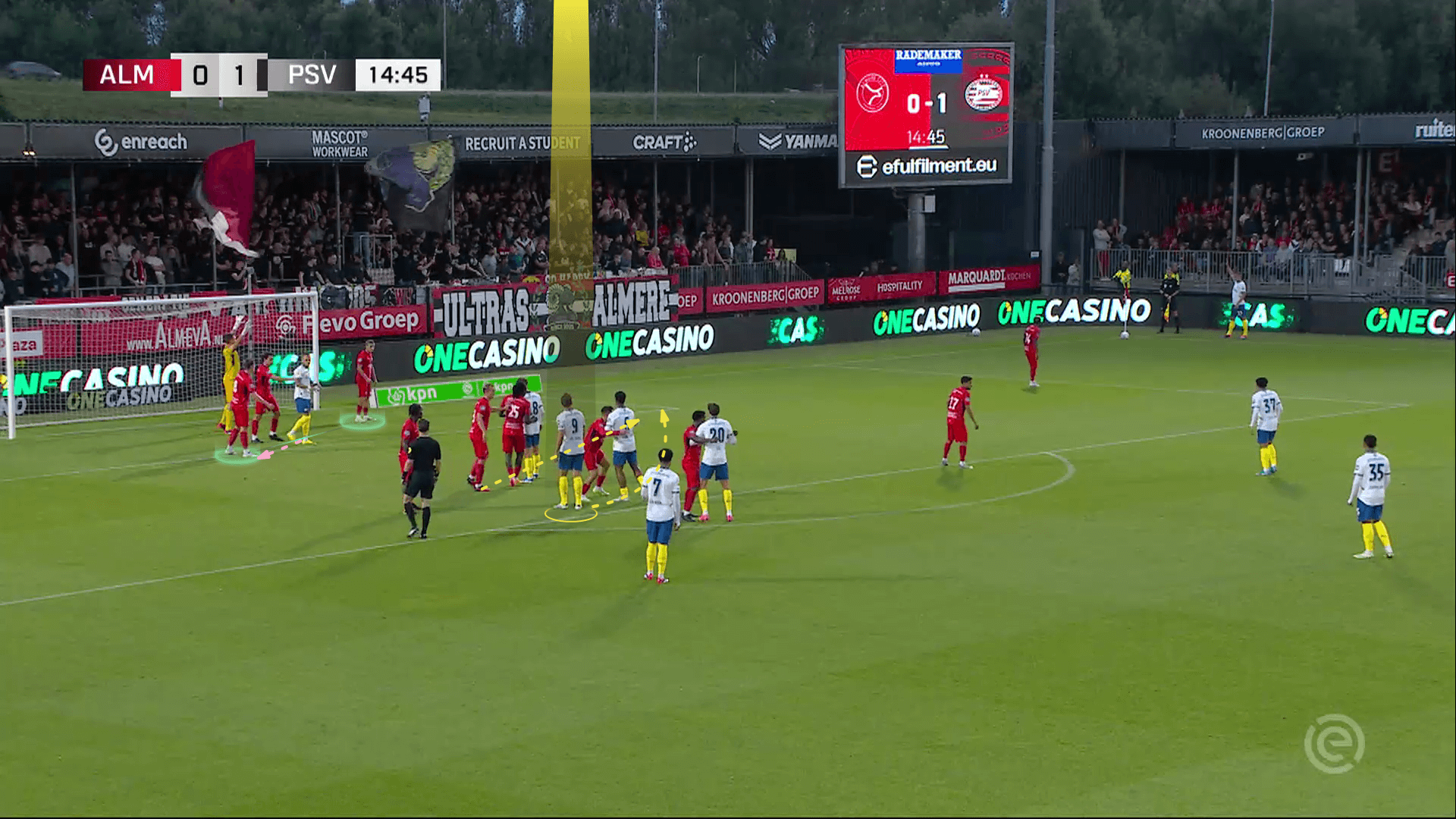
The separation between Luuk de Jong and his man marker is clear below.
The ball comes from a blind and far point to the first zonal defender, who starts to run late.
The out-swinging cross targets a slightly distant area, which makes it hard for him to get the ball, as shown below.
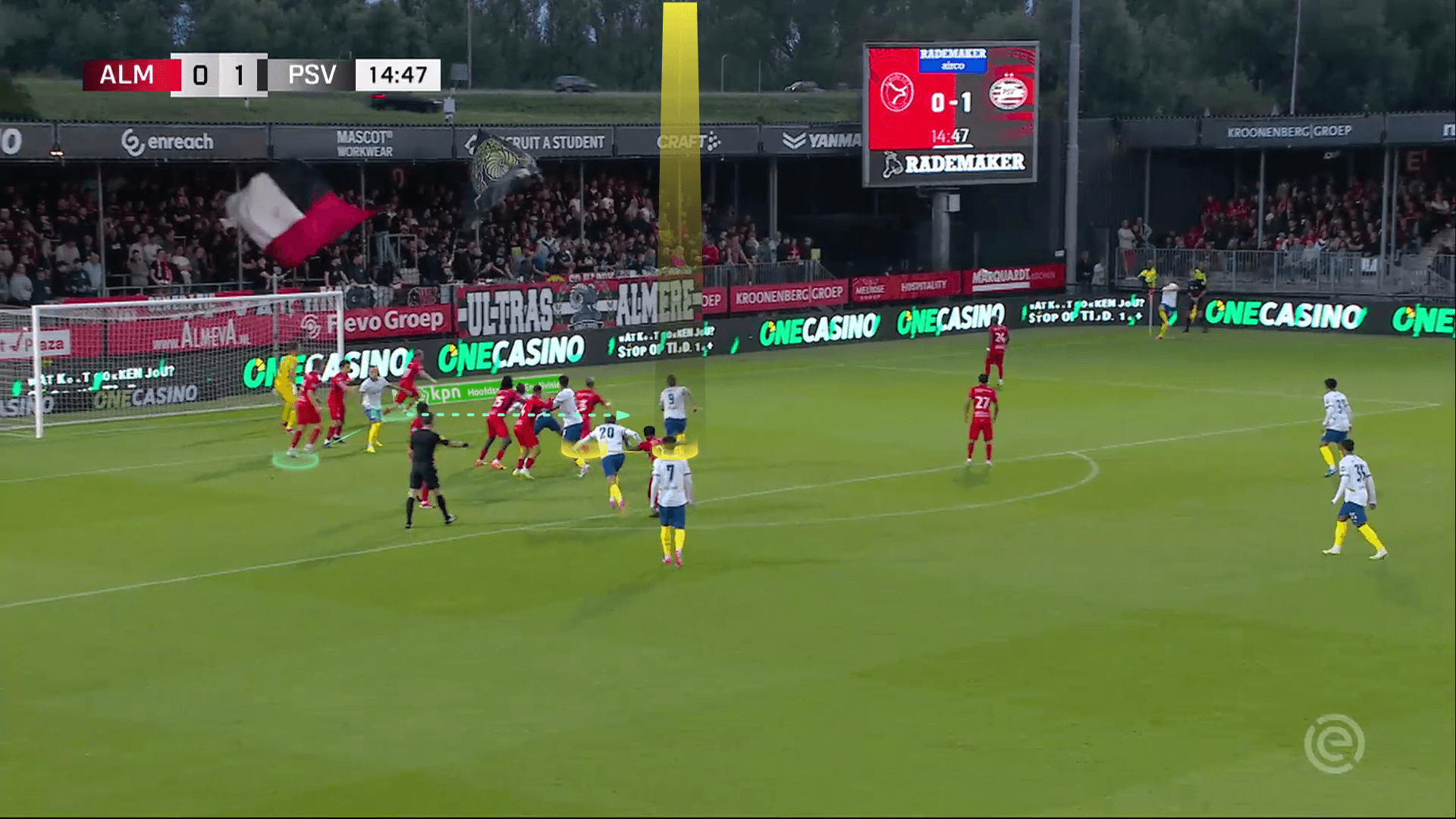
The low-level cross helps Luuk de Jong shoot it before his marker scores a goal in the end, as shown below.
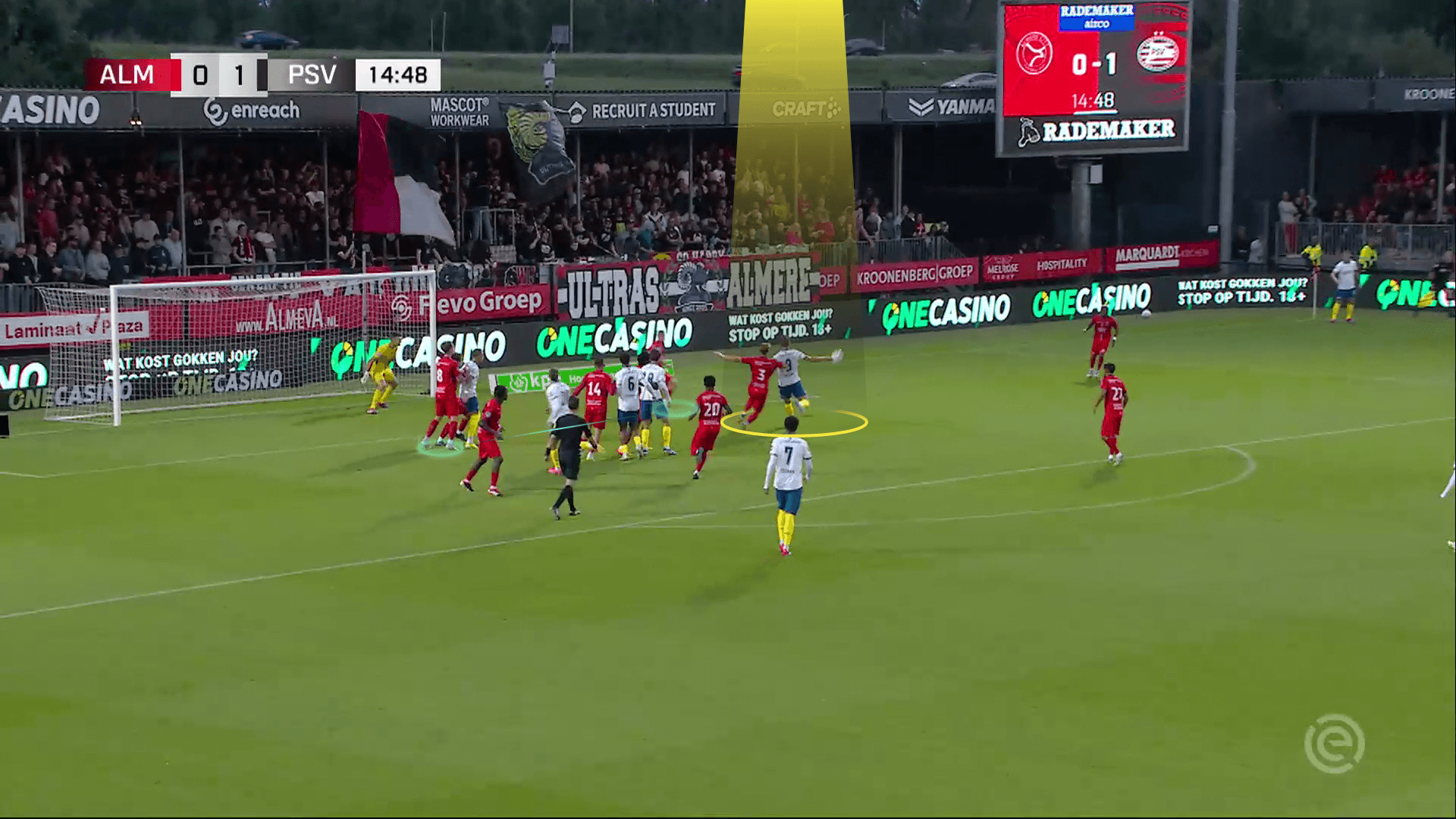
In the following corner, the first zonal defender (green) realises the idea and starts to run earlier.
The first zonal defender’s movement is shown below (green)
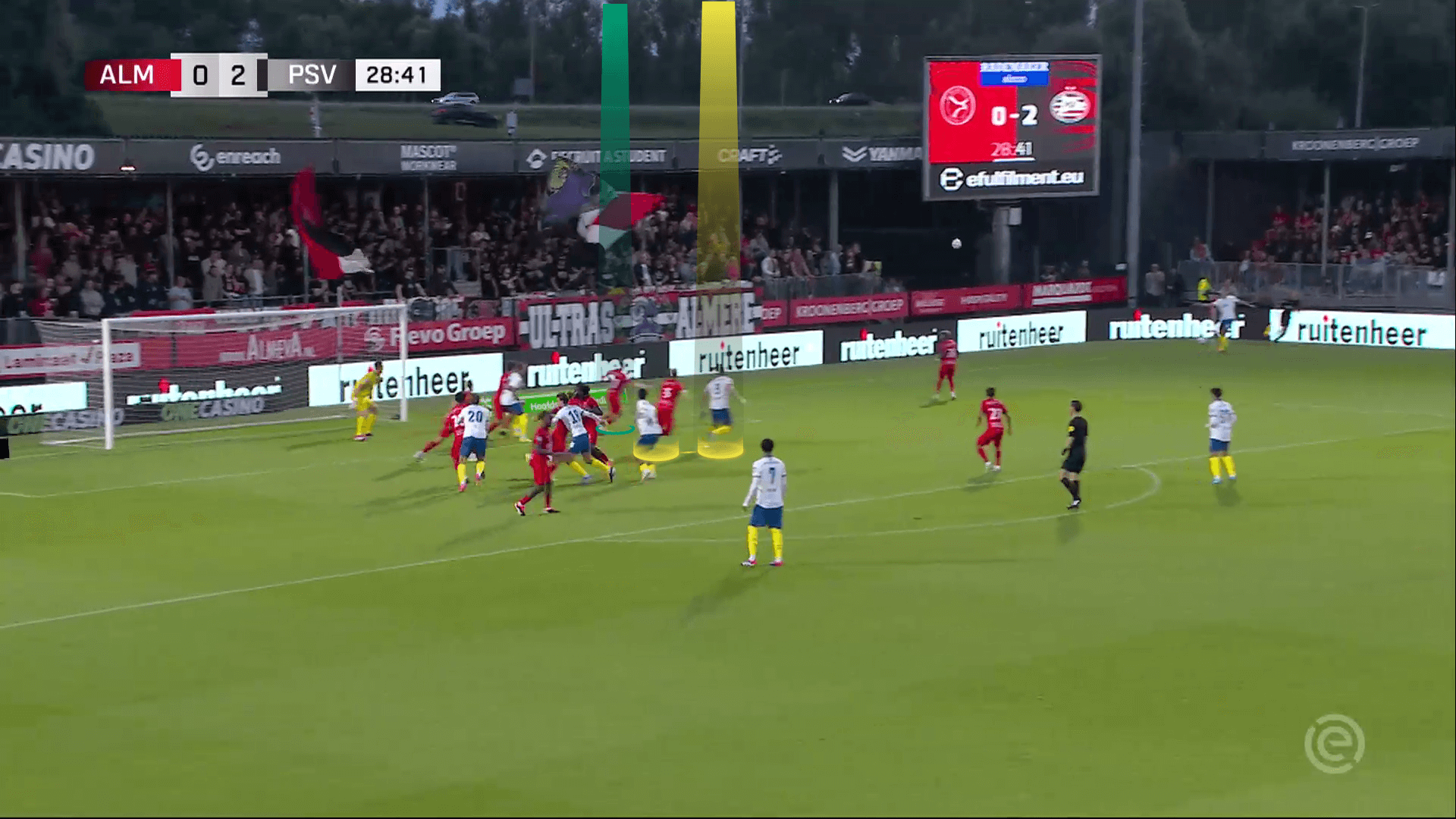
This makes it hard for Luuk de Jong to get the ball while the cross is also higher this time.
This makes us say that they should have a specific plan and not leave things to luck and repetition.
This is the difference between good teams and elite teams.
In this case, who should deal with the first zonal defender because we don’t play against statues, and opponents can expect our ideas?
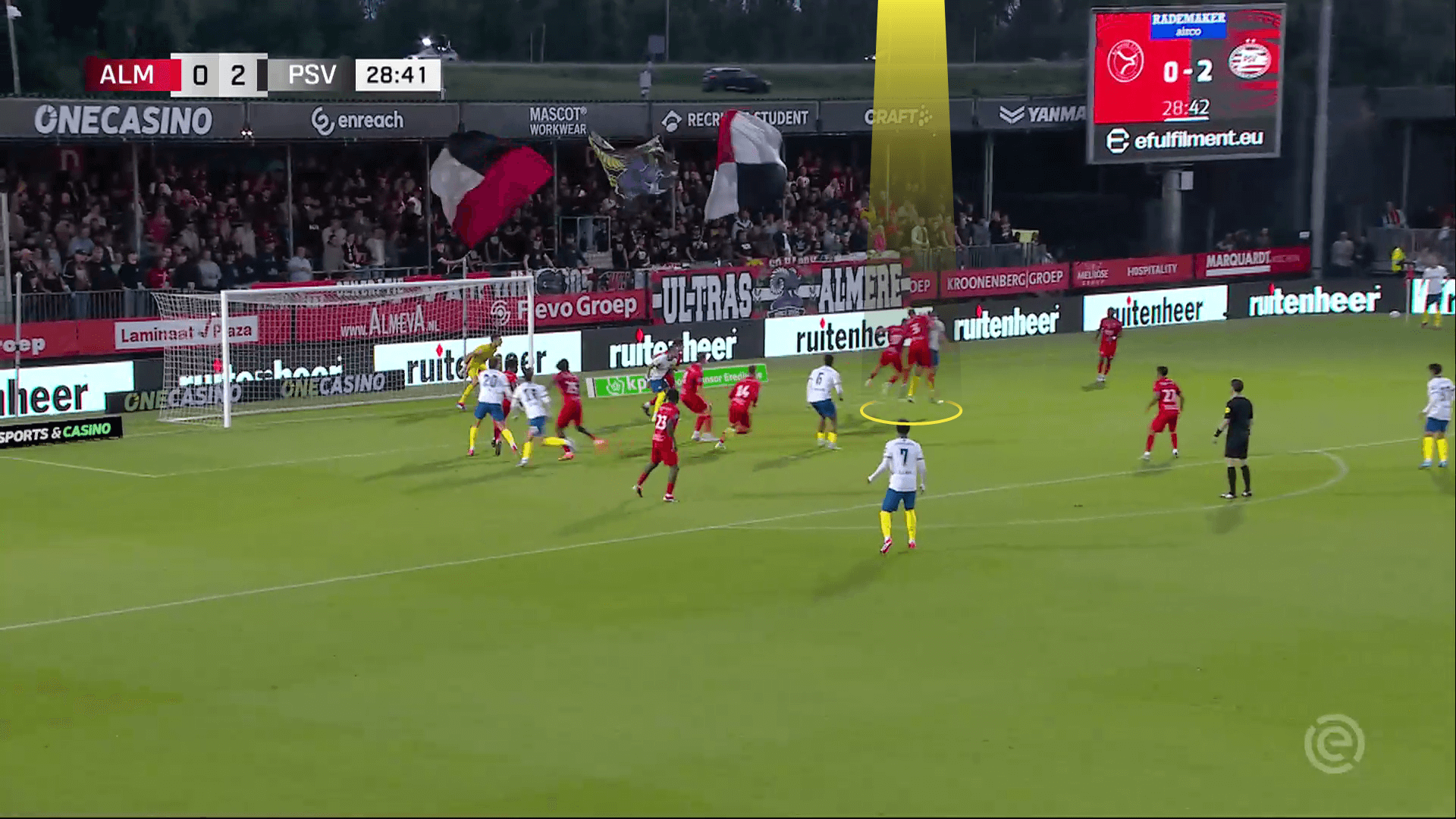
Targeting The Far Post
In a similar way, they target the far post by in-swing crosses.
Here, they play against only three man markers, meaning that one of their four runners is free.
In the photo below, the opponent defends with five zonal defenders, three man markers and two players on the edge of the box.
The two attackers in the six-yard box have different roles; one goes to delay the goalkeeper’s reaction while the other fakes a run to the near post to deceive the defence and be ready for any probable headed pass or clearance.
Luuk de Jong (green) turns around the pack to reach the targeted area as usual, but this time, the free player (yellow) has priority in targeting the ball while Luuk de Jong blocks the marker that tries to go to him.
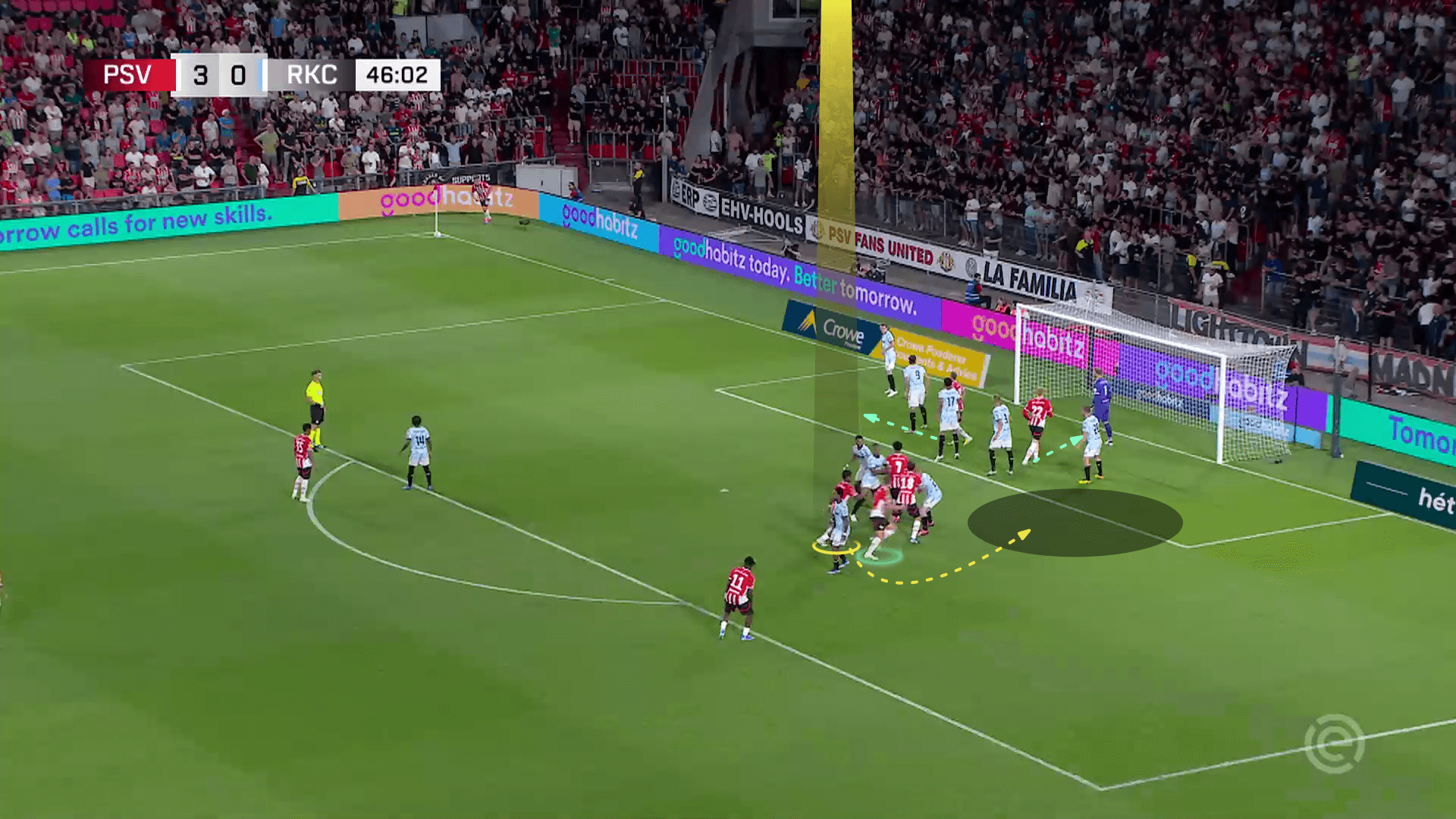
The plan works.
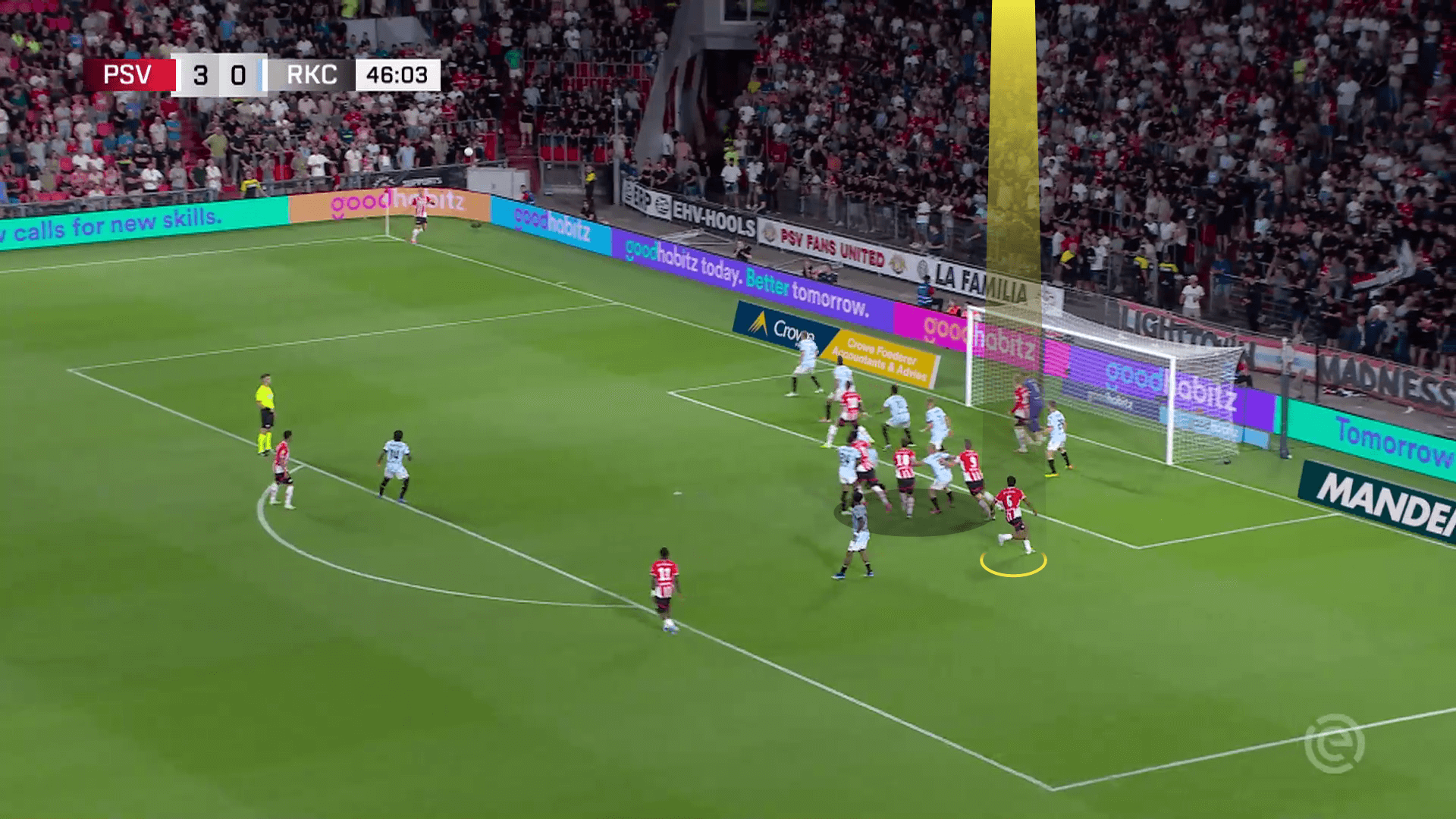
We should note that no one deals with the last two zonal defenders, whose reaction to the movement behind them is to step back to the goal, enlarging the targeted area’s space.
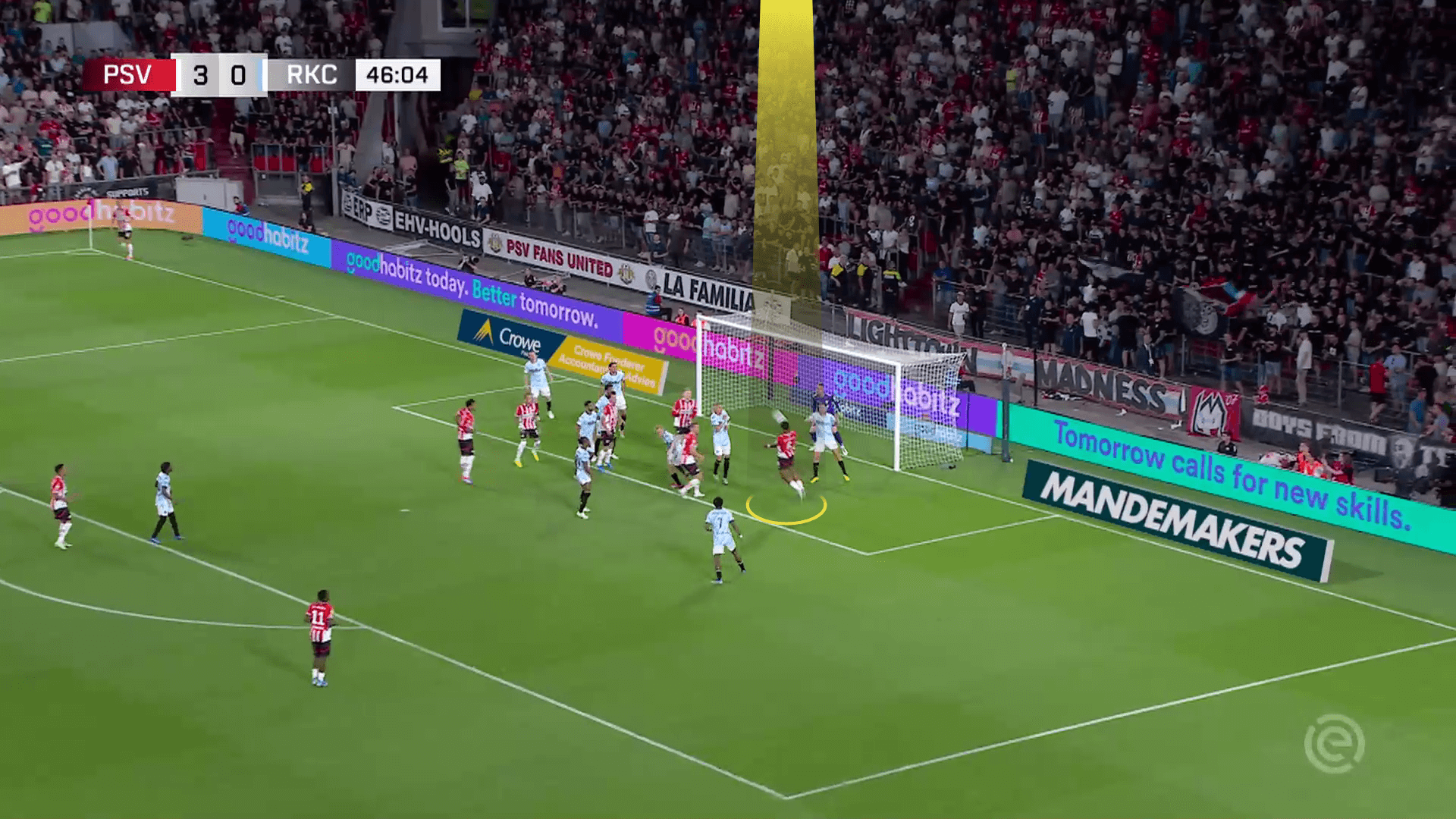
On the other hand, the same idea is implemented below, where the three runners try to drag and block the three man markers away from Luuk de Jong (yellow).
The first setup is shown below.
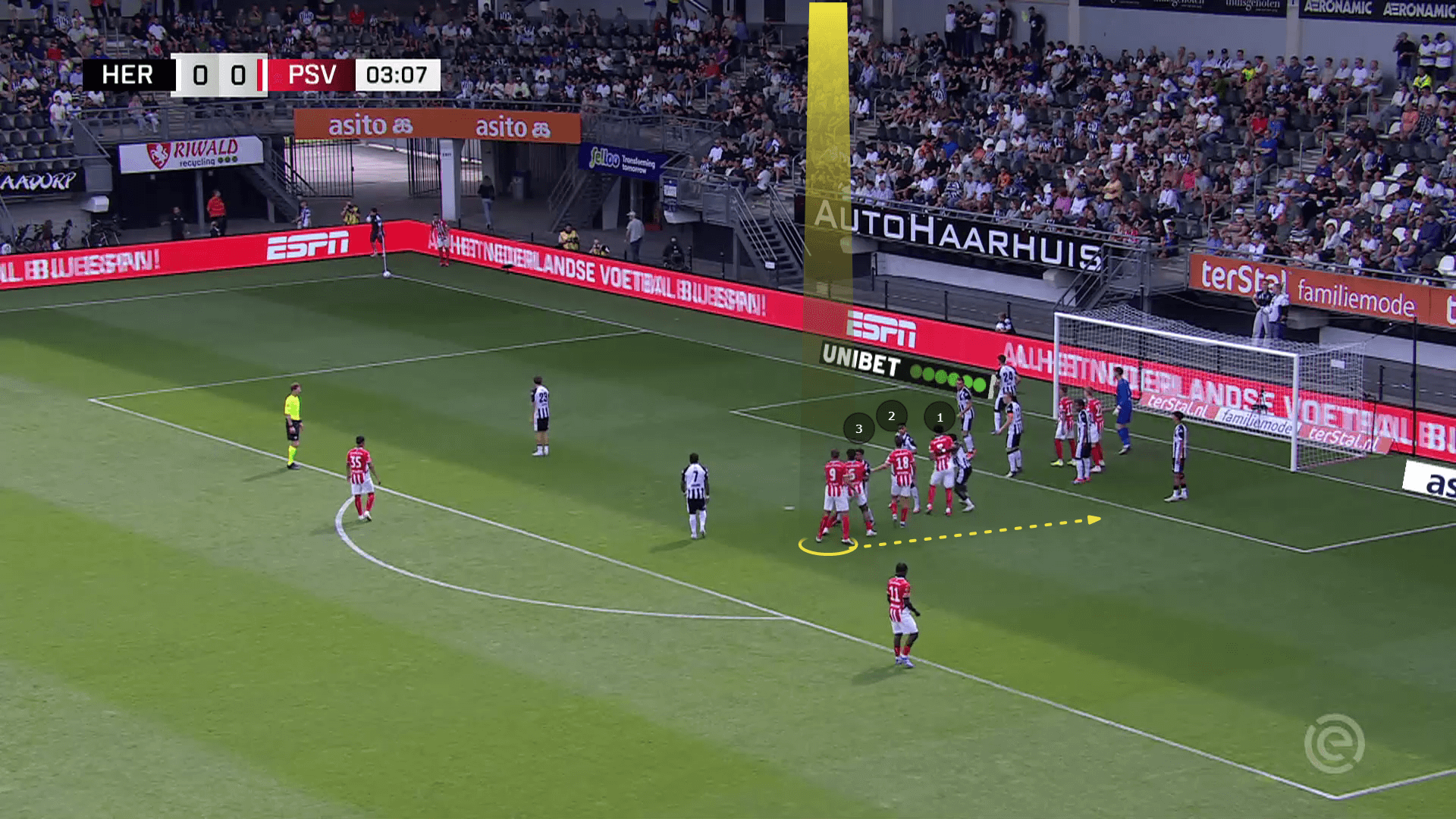
The first plan works, but the last zonal defenders didn’t shift back this time, so the targeted area has two zonal defenders (the last two).
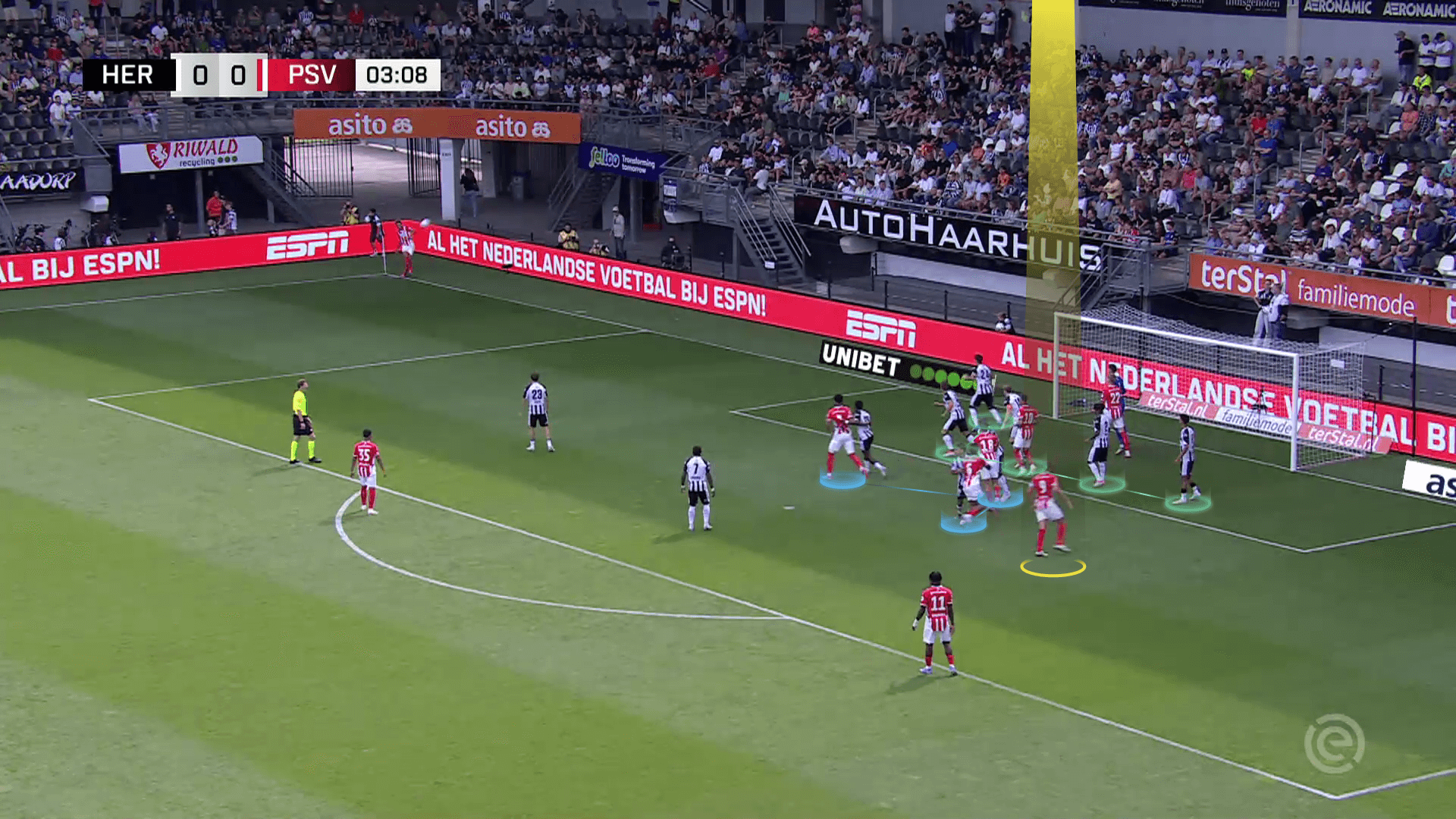
One of them clears the ball.
Here, we should repeat that paying attention to every little detail makes you act like the elite, so don’t miss the chance, especially if you are a good team with good ideas.
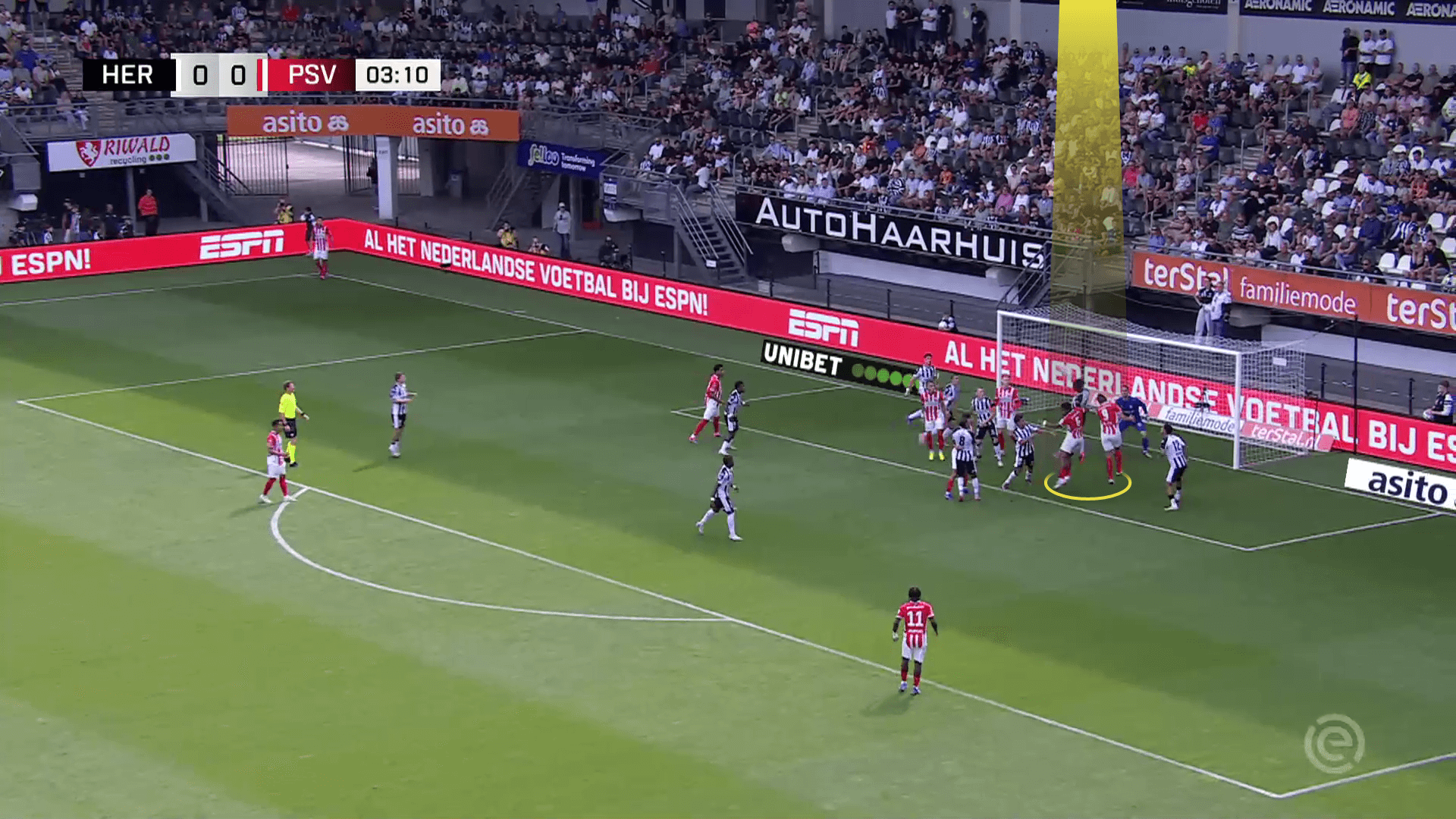
Short Corners
They have an excellent overlap idea to implement a sudden 2v1 situation in short corners.
In the photo below, the taker passes the ball and starts to overlap while the opponent has a short-option defender (blue), one zonal defender who comes to help (green) and a rebound defender (pink).
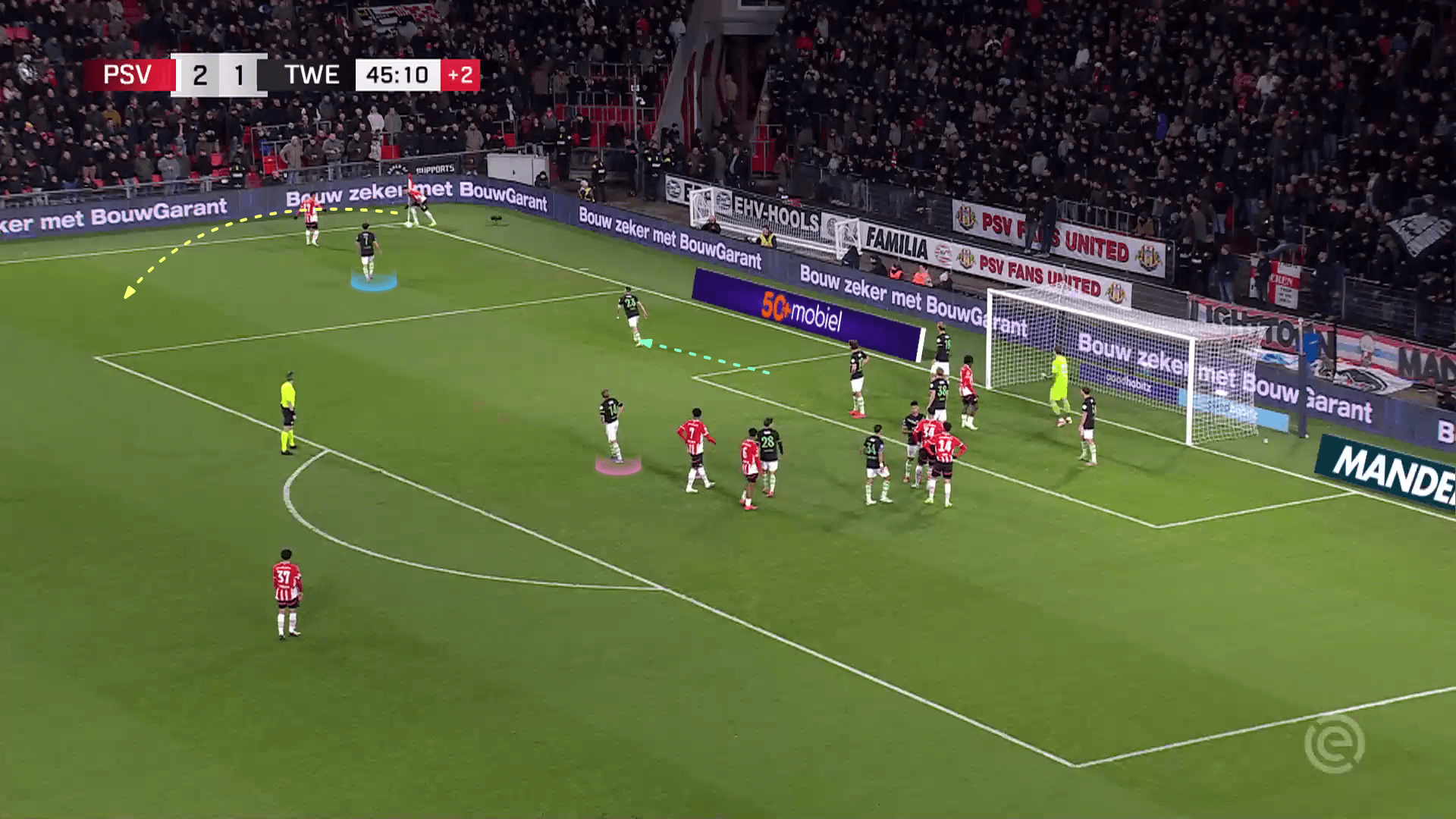
This creates a quick 2v1 situation over the short-option defender.
The zonal defender needs to cut a long way to help so the short-option attacker can pass the ball to the taker again to send a very dangerous cross from a nearby area (around the corner of the box).
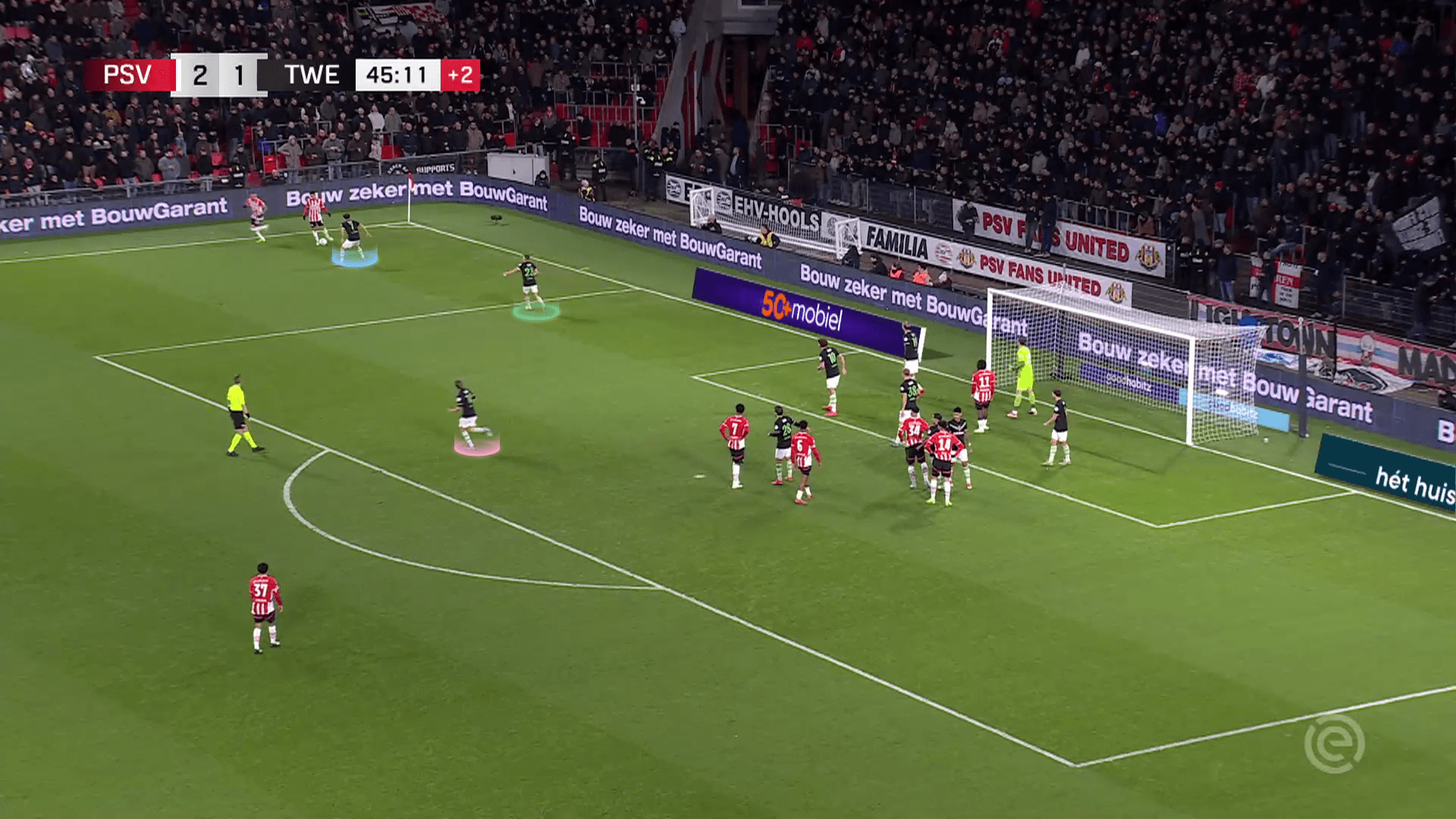
Alternatively, as shown below, he can fake that he will pass and dribble out to cross.
The two-versus-one situation is shown below.
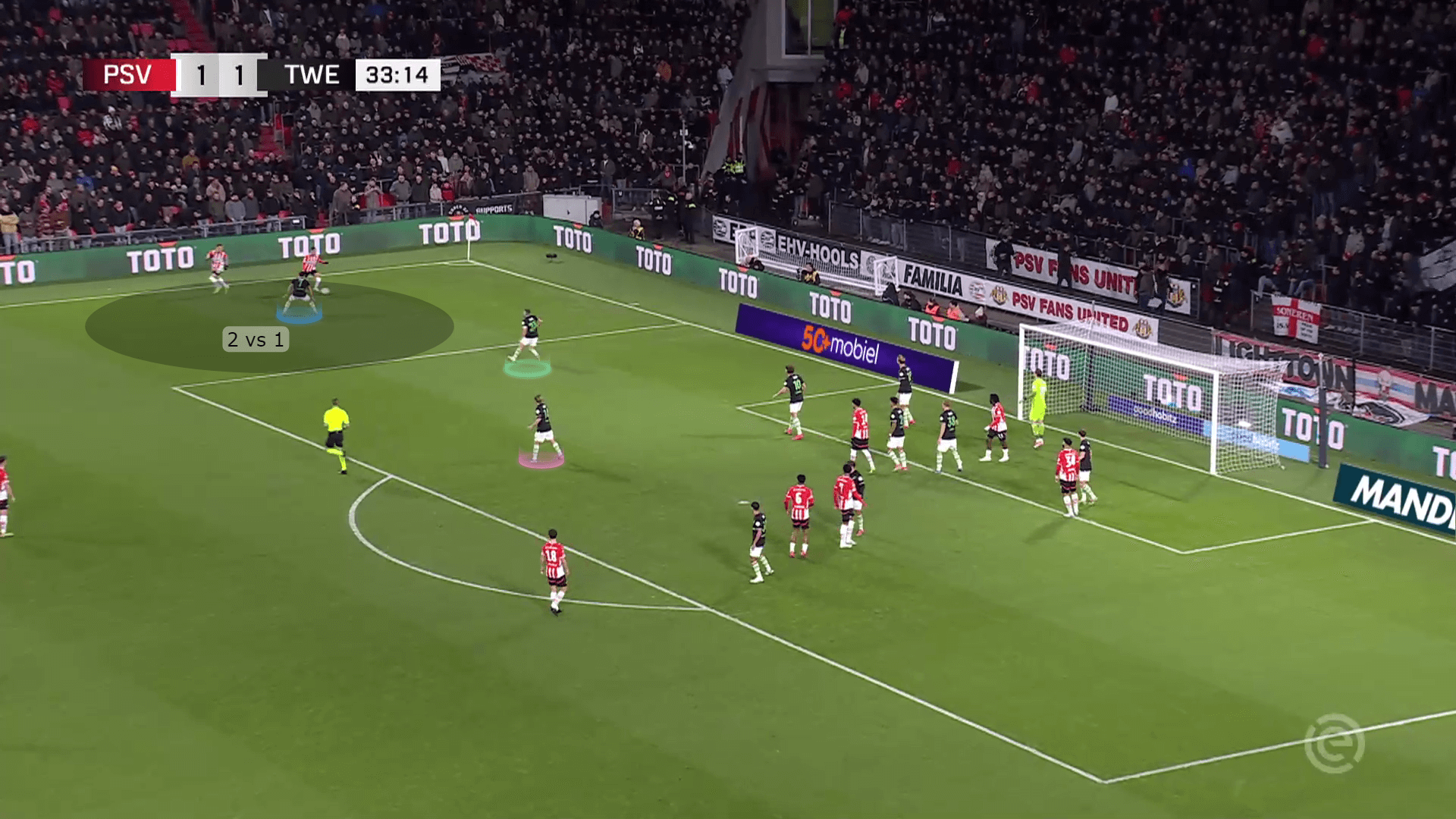
In another solution, they ask an attacker from the box to run in front of this first zonal defender (green) to prevent him from going up to help.
The other part of the plan inside the box is that the zonal line focuses on the ball during the short passes.
They face an orientation problem because they can’t track the ball in front of them, and the targeted player (yellow) attacks from the middle to the far post behind them during the short passes.
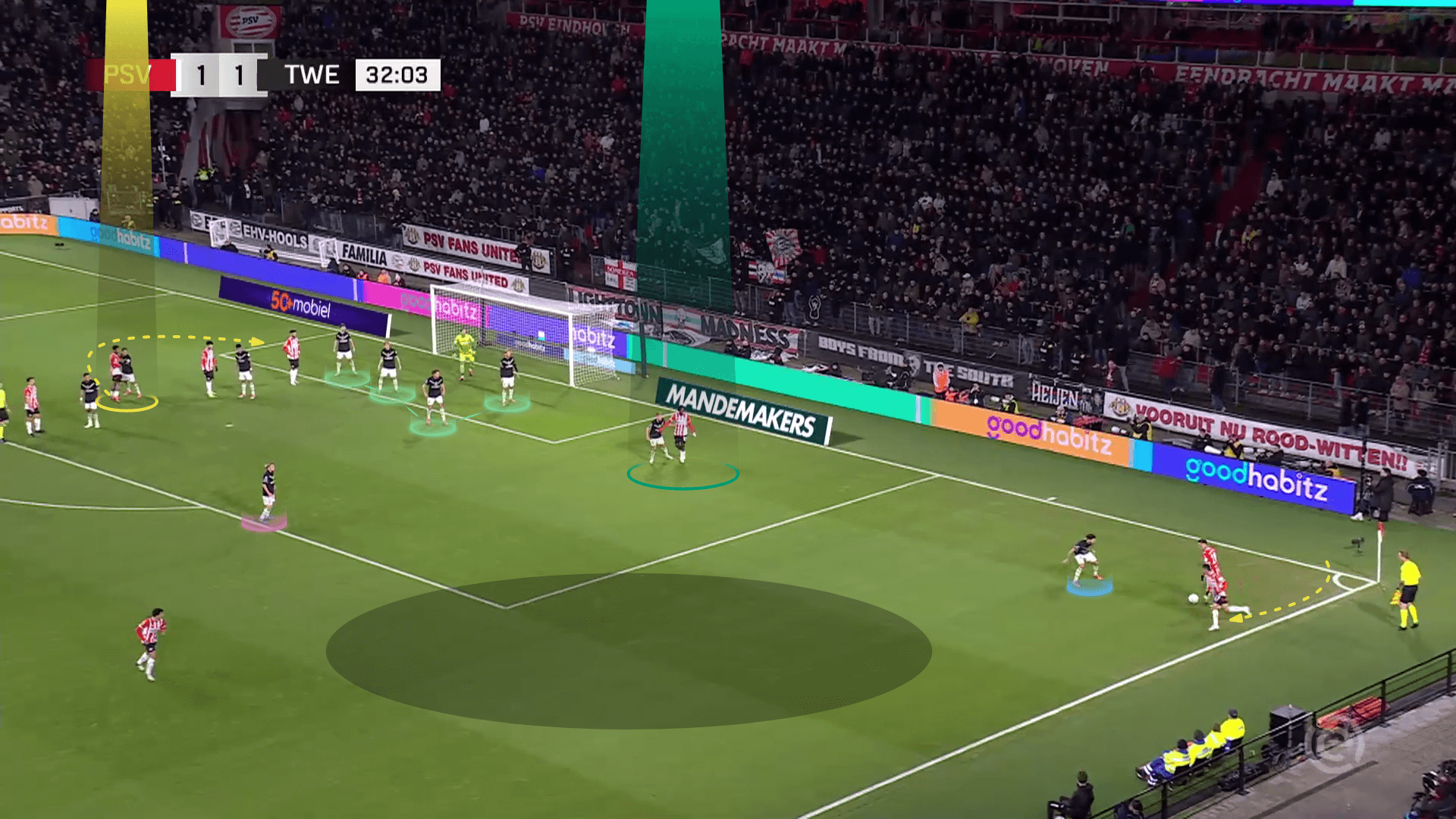
Three runners (orange) make fake decoy runs to catch the attention of the last zonal defender and target the area beyond the far post, as shown below.
The man marker also faces a tough orientation problem because he is based on keeping tracking the attacker while he moves away from the ball.
You can see that he loses contact with the ball below.
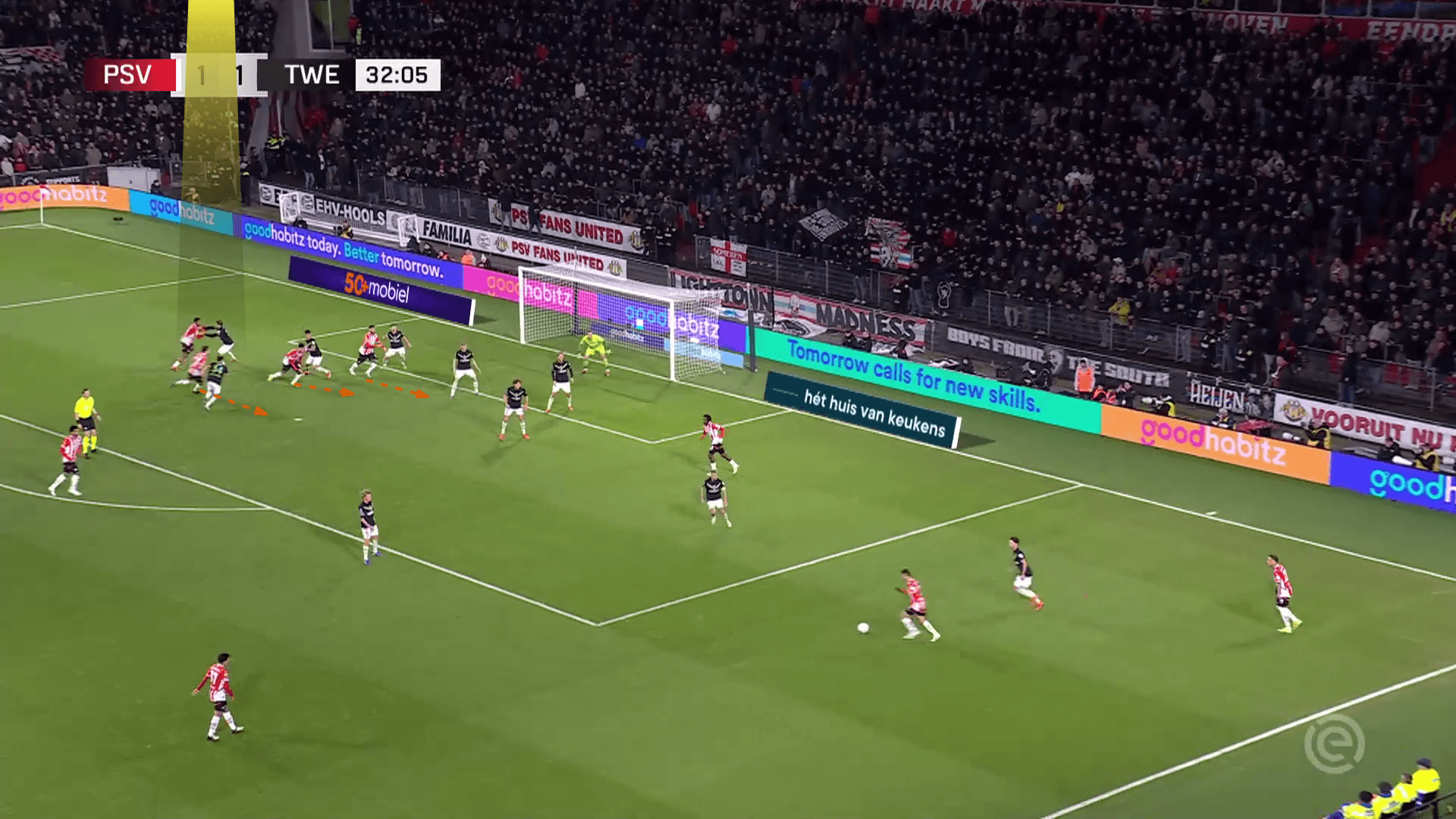
When he tries to take a look at the ball, the targeted player turns around, making the marker lose contact with him.
This gives the attacker the advantage in most cases, as shown below.
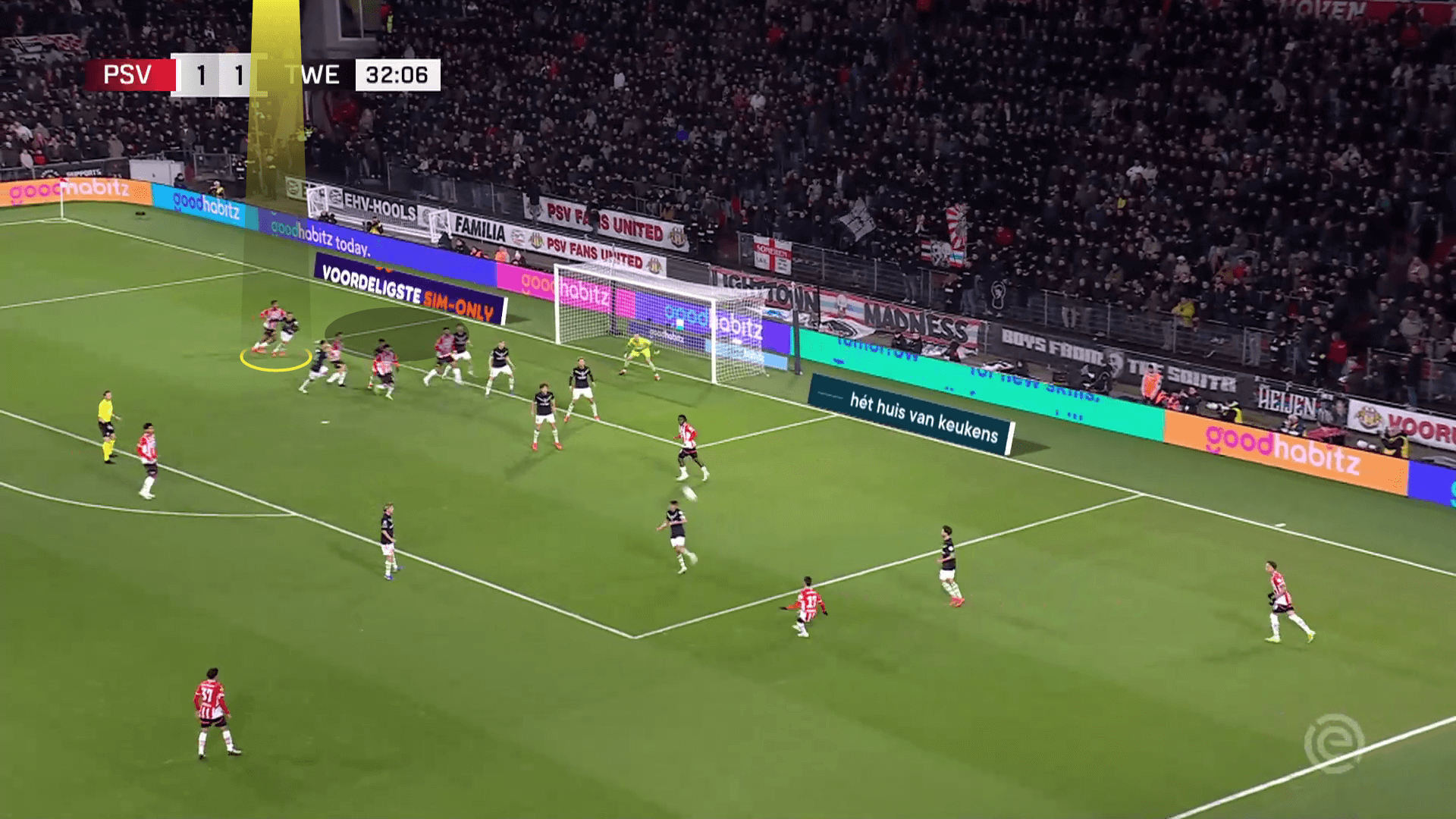
Some teams ask the rebound defender to go to help quickly in this 2v1 situation because he is nearer to help than the first zonal defender, as shown below.
The photo below shows the first defending action.
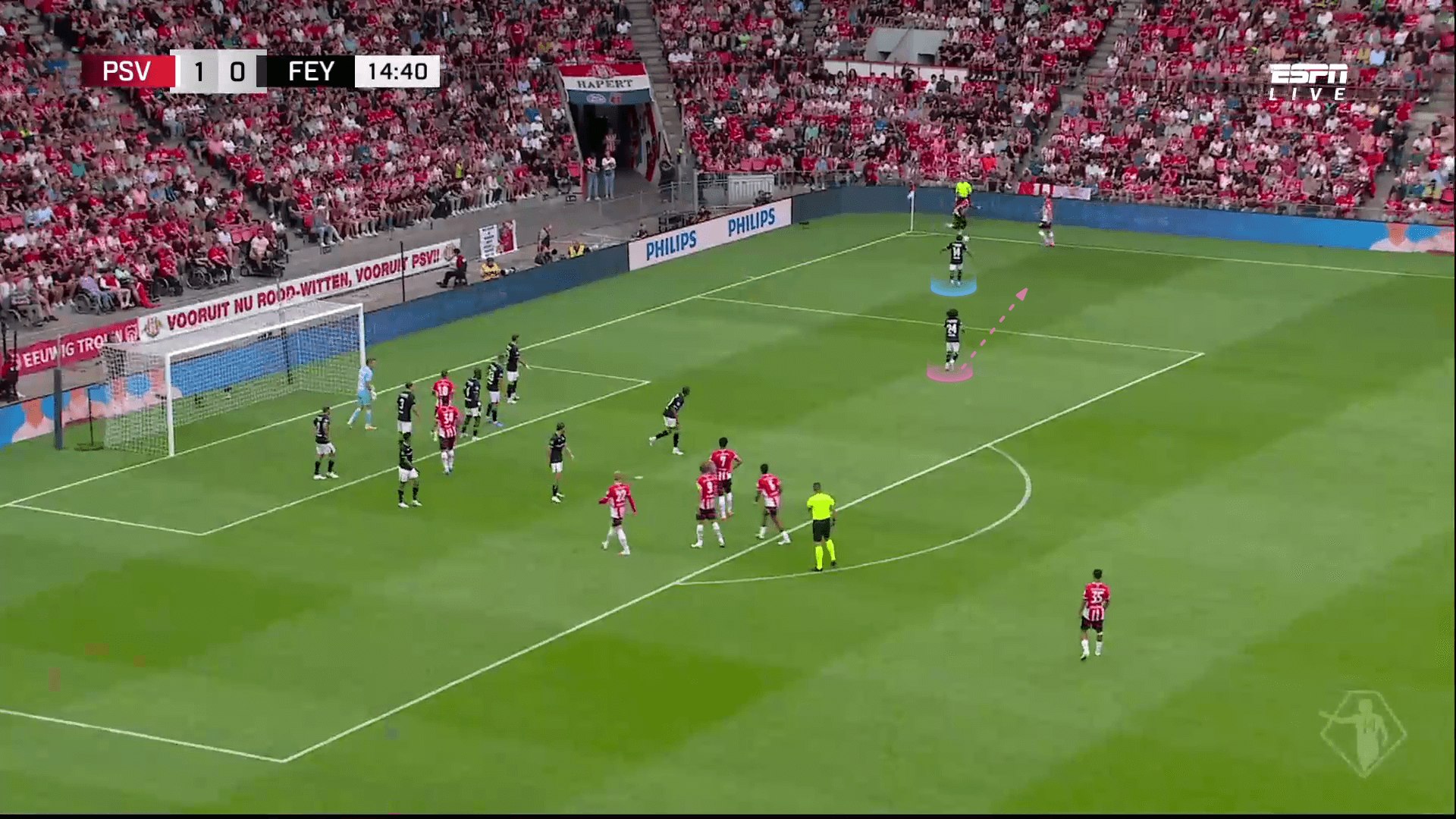
They have a variation of passing the ball to the player coming from the back, who will be the one to cross the ball.
The rest of the plan continues as normal.
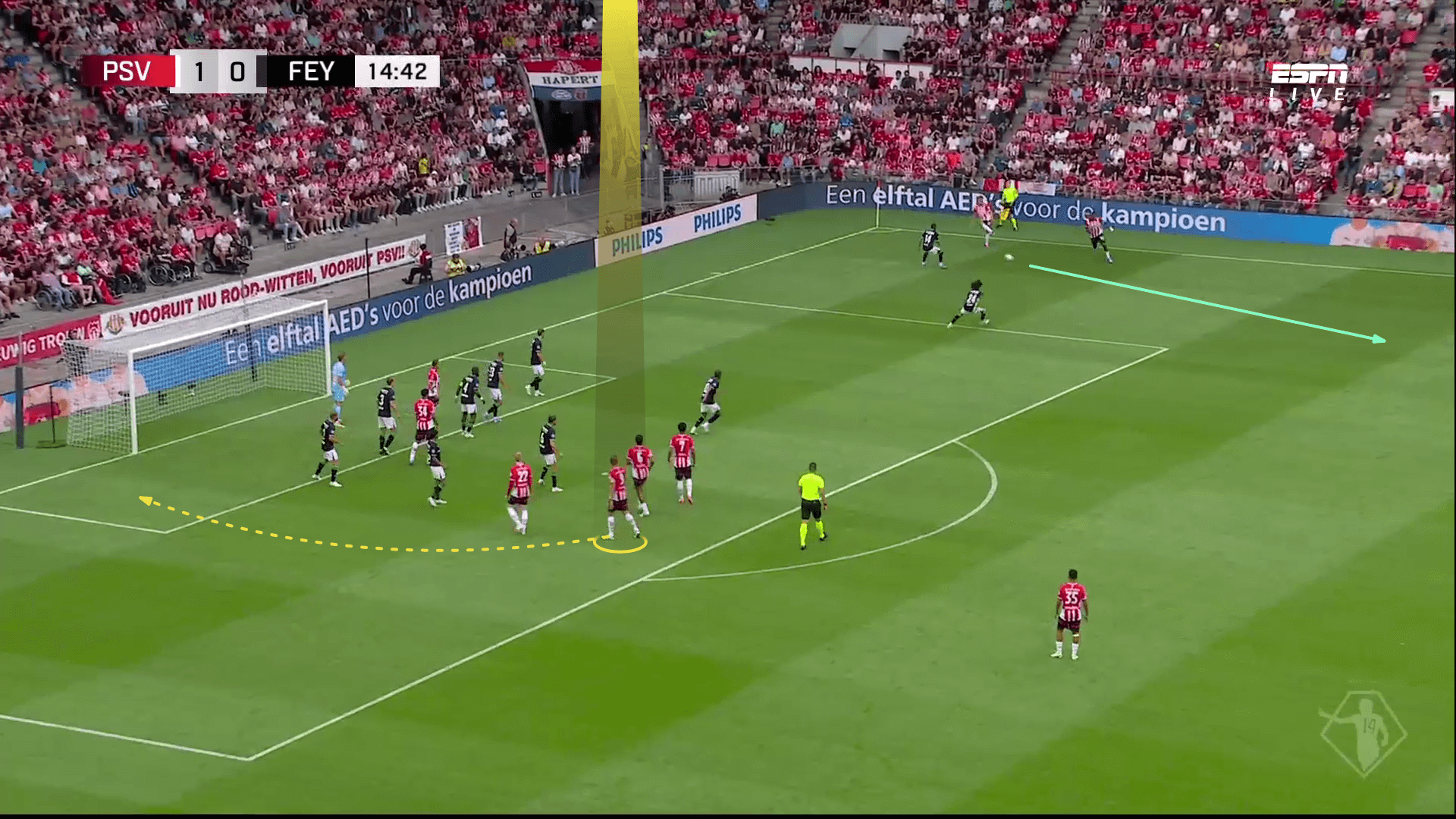
Go Ahead Eagles’ Counter Defending Ideas
Go Ahead Eagles implemented a good defensive scheme to stop PSV and their set-piece ideas.
Let’s demonstrate that.
In the first photo below, they defend with five zonal defenders standing on the edge of the six-yard line — ready for the out-swinging cross — and two man markers (pink) to mark Luuk de Jong and Ryan Flamingo, #6.
The rebound defender helps in blocking and then goes back to his rebound role.
They choose not to mark totally with four man markers evacuating the area between the zonal line and the runner, so they see just two man markers and two players (yellow) awaiting in the valuable areas in the second line.
If any runner escapes from his man marker or runs into a valuable area, they start the process of grappling, as shown in the second photo below.
If there are no short attackers, the short-option defender starts in a good position, making him able to cut the path of their usual out-swing cross, as has already happened in this case.
In short corners, they have a suitable method, as in the third and fourth photos.
The zonal defender comes to help from outside while the short-option defender tries to close the back pass as much as he can and then continues with the taker, leaving the short option with the incoming zonal defender.
The rebound defender goes to press the back-pass option, but he closes the passing option to the rebound attacker behind him and then, he goes to press quickly, as in the fourth photo.
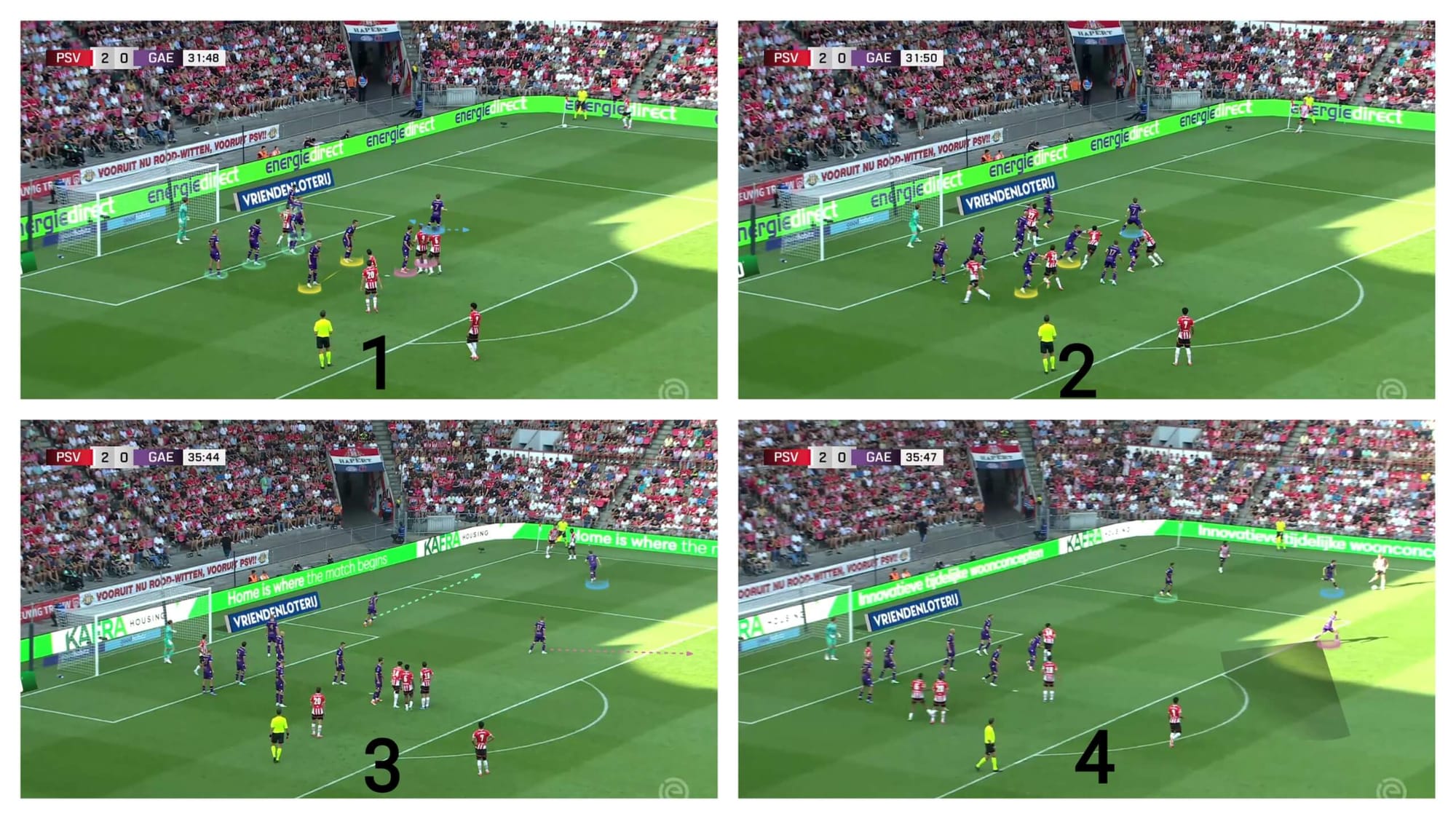
Conclusion
In this analysis, we have shown how PSV is excellent at attacking corners.
So far, they have scored seven goals from corners in the Eredivisie and two in the UEFA Champions League, the best in both.
In this set-piece analysis, we have also shown how they are diverse in their attacking ideas and how teams may be able to stop them.






Comments